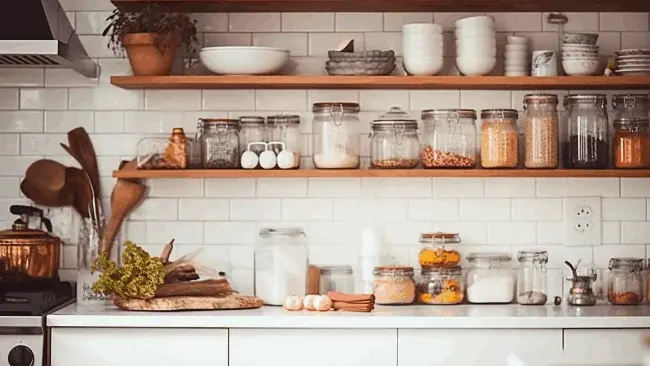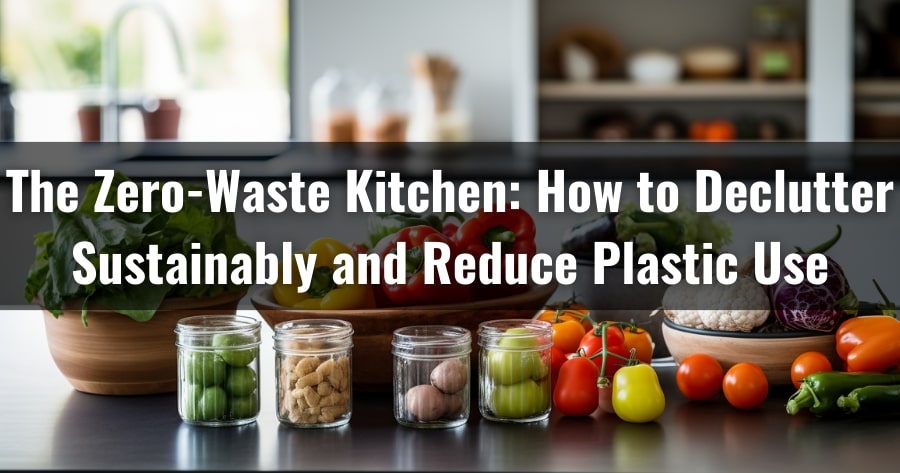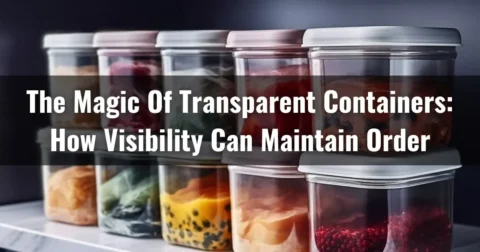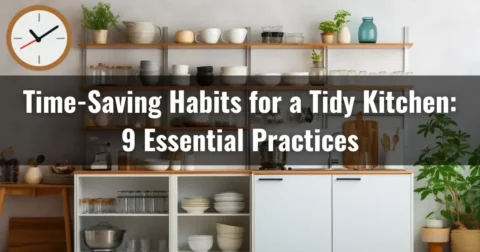Reducing plastic waste and living a sustainable life are not just trendy buzzwords but a necessity for a healthier planet for future generations. Incorporating the zero-waste philosophy into your kitchen can significantly reduce waste and mitigate its harmful effects.
As we all know, the kitchen is the heart of the home, where we cook, eat, and spend quality time with our loved ones. Unfortunately, it is also where we generate a lot of plastic waste. It’s time to look at our habits and make small changes in our daily routines to help make the planet a better place to live in.
With this article, we will share practical steps and advice to help you declutter your kitchen sustainably and reduce plastic usage in your kitchen without sacrificing convenience or functionality. Let’s get started.
Jump to Section
How to Declutter Kitchen and Stay Sustainable?

Ready to declutter your kitchen and stay sustainable? Follow these five steps to transform your kitchen into an organized, eco-friendly space.
- Assess your current kitchen clutter
- Plan and prepare for organizing
- Declutter like a boss
- Drop off donations
- Optimize your organization
Step 1: Assess Your Current Kitchen Clutter
Evaluate the extent of the clutter in your kitchen carefully. Look thoroughly at each kitchen area, from the countertops to the cabinets. Is your cutlery drawer overflowing? Are your countertops cluttered with appliances and utensils you rarely use?
You can develop targeted solutions once you clearly understand the cluttered zones. Take note of any expired items in your pantry or fridge and make a plan to dispose of them properly.
Step 2: Plan and Prepare for Organizing
To effectively plan and prepare for sustainably organizing your kitchen, it’s essential to assess and evaluate your current clutter regularly.
Take the time to go through your kitchen and identify areas that need attention. Create a checklist of the specific areas you want to tackle and potential sustainable solutions you can implement. This will help you stay focused and organized throughout the decluttering process.
Step 3: Declutter Like a Boss
Now, start decluttering your kitchen like a boss by prioritizing one zone or category at a time. This focused approach will help you stay organized and make the process more manageable.
Begin with your countertops, a space that tends to accumulate clutter. Take a look at what you have and consider what you truly need.
Edit your cutlery drawer by keeping only the essentials and donating any unused gadgets. Clear unnecessary items from your worktops to create a clean and functional space.
Step 4: Drop Off Donations
After sorting through your kitchen items and identifying what you no longer need, finding the right place to donate them is important.
Look for local charities, shelters, or community organizations that accept kitchen items. You can also consider donating to thrift stores or second-hand shops that support sustainable practices.
Step 5: Optimize Your Organization
After dropping off your donations, it’s time to optimize your kitchen organization sustainably and create a clutter-free space that promotes a zero-waste lifestyle.
Maximizing efficiency is key. Keep items close to where they’re used to save time and effort. Utilize drawer and wall space to store utensils, pots, and pans. Consider using hooks or magnetic strips to hang frequently used tools.
What Can You Do to Reduce the Kitchen’s Plastic Usage?

Reducing plastic use in the kitchen minimizes our ecological footprint and sets the stage for a healthier and more environmentally conscious lifestyle. Carefully following these steps will reduce your kitchen’s plastic usage:
Observe and Track Plastic Waste
Start by conducting a bin audit to observe and track your plastic waste in the kitchen. This simple yet effective exercise will provide valuable insights into the types and quantities of plastic items you throw away.
By understanding your plastic waste habits, you can make informed decisions about alternatives and focus on areas where reduction is most achievable. Take note of the plastic packaging from your groceries, the disposable cutlery and straws you use, and any other single-use plastic items in your kitchen bin.
Keep a record for a week or even a month to get a comprehensive view of your plastic consumption. With this knowledge, you can explore ways to reduce your plastic use and make more sustainable choices in your kitchen.
Gradual Transition to Reusable Alternatives
To reduce your plastic use in the kitchen, gradually transition to reusable alternatives by replacing single-use plastic items with eco-friendly options. This simple change can significantly impact reducing waste and promoting sustainability.
- Start by swapping plastic wrap with beeswax wraps or silicone food covers. These alternatives are reusable, easy to clean, and can keep your food fresh like plastic wrap.
- Another easy switch is using stainless steel or glass food containers instead of disposable plastic ones. These containers are durable, non-toxic, and can be used for years.
- Invest in reusable silicone or cloth food bags for storing snacks and produce. These bags are washable, lightweight, and perfect for reducing the need for plastic bags.
Creative Reuse of Existing Plastic
Instead of throwing away yogurt pots, take-out containers, and other plastic items, consider using them for food storage. These containers can be perfect for preserving leftovers or packing lunches.
You can also use plastic bottles as water containers for your plants or as a makeshift watering can.
Get creative with your plastic cutlery and turn them into garden markers by labeling them with the names of different plants. Another idea is to repurpose plastic lids as coasters or as a base for small plant pots.
Mindful Shopping Practices
When shopping for your kitchen, be mindful of using packaging-free or plastic-alternative options. Opt for bulk items to minimize packaging waste and choose products that come in recyclable or cardboard packaging instead of plastic alternatives.
Avoid individually wrapped items, as they often generate unnecessary plastic waste. By adopting these mindful shopping practices, you can significantly reduce the amount of plastic entering your kitchen and contribute to a more sustainable lifestyle.
Also, supporting sustainable and waste-conscious brands can positively impact the environment. Look for companies that prioritize eco-friendly packaging and strive to reduce their plastic use.
Sustainable Food Storage Alternatives
One way to cut down plastic use in your kitchen is by considering sustainable food storage alternatives. Instead of using plastic containers, you can reuse glass jars for storing food. Not only is this an eco-friendly option, but it also helps to minimize waste.

Another alternative is durable silicone storage bags, which can be used repeatedly. They’re perfect for storing leftovers or packing snacks for on-the-go.
Plastic-Free Meal Preparation Tools
Choose sustainable alternatives for meal preparation tools to minimize plastic use in your kitchen. By making a few simple swaps, you can significantly decrease your plastic consumption while still enjoying the convenience of modern kitchen gadgets.
- Look for non-toxic silicone or bamboo spatulas, which aren’t only plastic-free but also durable and heat-resistant.
- Glass bowls are an excellent alternative to plastic mixing bowls, as they’re versatile, easy to clean, and don’t leach harmful chemicals into your food.
When cutting boards, opt for sustainable bamboo instead of plastic. Not only is bamboo a renewable resource, but it’s also naturally antimicrobial, making it a safe and eco-friendly choice.
Smart Kitchen Cleanup Techniques
Adopt smart kitchen cleanup techniques that promote sustainability and minimize waste to reduce plastic use in your kitchen further.
Instead of disposable paper towels, opt for slop rags made from old t-shirts. These can be used for wiping counters, cleaning spills, and other tasks.
To prevent cross-contamination, designate specific towels for food-related tasks. This way, you can avoid using disposable wipes or paper towels for every little mess.
Also, you can manage kitchen waste without using plastic bin liners by segregating recyclables and compostables. Use separate bins or bags for plastics, glass, metal, paper, and organic waste.
Commitment to Progress
You can make a significant impact on reducing plastic use in your kitchen by taking sustainable steps.
Start by advocating for reusable items and actively avoiding single-use plastics. Instead of plastic wrap, use reusable silicone covers to keep your food fresh. Replace plastic storage containers with glass or stainless steel alternatives.
When shopping, choose products with plastic-free packaging, such as bulk items or those packaged in paper or cardboard. Additionally, consider investing in reusable produce bags and bringing your shopping bags to reduce plastic waste.
FAQ’s
What are the harmful effects of plastics in the kitchen?
There is no denying the convenience of plastics in the kitchen, but studies have uncovered the potential harm they can inflict on our health.

From birth defects and infertility to cognitive decline and cancer, the chemicals found in plastics have been linked to some serious health conditions.
Why should we stop using plastic in our kitchen?
We should stop using plastic in our kitchen because it can harm our health. When heated, plasticizers like BPA and phthalates can leak into the food we are cooking or reheating. This contaminates our food with toxins, which can be harmful to our bodies when consumed.
It is especially important to avoid microwaving fatty foods such as meat and cheese in plastic containers as they are more likely to absorb these harmful substances. By switching to alternative materials such as glass or stainless steel, we can ensure that our food remains safe and healthy.
Conclusion
Decluttering your kitchen and reducing plastic waste isn’t only sustainable but also a step towards a more eco-friendly lifestyle. Implementing the strategies mentioned in this article can transform your kitchen into a zero-waste haven.
Zero-waste kitchens are like well-organized pantries; they lead to success. So roll up your sleeves, grab those reusable containers, and embark on a greener future.
We hope this article has helped inspire you to declutter sustainably and reduce plastic use in your kitchen. Never forget that every small action counts; together, we can create a world where waste reduction is the norm, not the exception.





